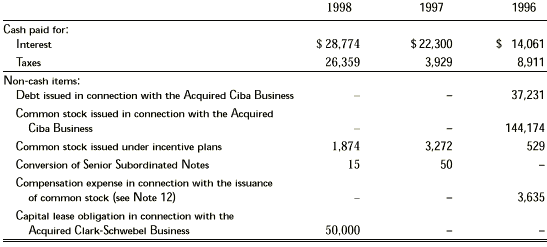|
Notes
to the consolidated financial statements
(continued) |
N o t e 9 - R e l a t e d P a r t i e s
In connection with the purchase of the Acquired Ciba Business, Hexcel delivered 18,022 newly issued shares of Hexcel common stock to Ciba, representing 49.9% of the Hexcel common stock issued and outstanding at that date. In addition, the company and Ciba entered into the Strategic Alliance Agreement which currently provides for, among other things, the designation by Ciba of four of the company’s ten directors, and the approval of a majority of these four designated directors for the taking of certain significant actions by the company. On February 21, 1997, the company consented to an assignment by Ciba of Ciba’s rights and obligations under the Strategic Alliance Agreement to CSC. In connection with the assignment of these rights and obligations, all of the Hexcel common stock previously held by Ciba is now held by CSC.
As discussed in Notes 2 and 7, Hexcel delivered Ciba Senior Subordinated Notes in an aggregate principal amount of $37,476 to Ciba in connection with the purchase of the Acquired Ciba Business. In connection with the assignment of Ciba’s rights and obligations under the Strategic Alliance Agreement, the Senior Subordinated Notes that were previously payable to Ciba are payable to CSC. During 1996, the company also delivered Senior Demand Notes to Ciba in an aggregate principle amount of $5,329. The Senior Demand Notes were presented for payment and paid in full prior to December 31, 1996. Aggregate interest expense on the Ciba Senior Subordinated Notes in 1998, 1997 and 1996, was $2,811, $2,762 and $2,715, respectively.
Hexcel purchases certain raw materials from various CSC subsidiaries. The company’s aggregate purchases from CSC subsidiaries for 1998, 1997 and 1996 were $37,717, $34,255 and $15,116, respectively. Aggregate payables to various CSC subsidiaries included in “accounts payable” and “accrued liabilities” as of December 31, 1998 and 1997, were $3,314 and $1,196, respectively. In addition, the company sold certain finished products to the affiliates of CSC (“Ciba Distributors”) pursuant to a distribution agreement, which expired February 28, 1997. For the year ended December 31, 1998, there were no sales to Ciba Distributors. For the years ended December 31, 1997 and 1996, aggregate sales to Ciba Distributors were $5,620 and $32,408, respectively. As of December 31, 1998 and 1997, aggregate receivables from Ciba Distributors were not material to the accompanying consolidated balance sheets.
N
o t e 1 0 – R e t i r e m e n t a n d O
t h e r P o s t r e t i r e m e n t
B e n e f i t P l a n s
Retirement Plans
Hexcel maintains defined benefit retirement plans covering most U.S. and
certain European employees as well as retirement savings plans covering
eligible US employees. The defined benefit retirement plans are based
on years of service and employee compensation under either a career average
or final pay benefits’ method. Hexcel’s funding policy is to contribute
the minimum amount required by applicable regulations.
In addition, the company participates in a union sponsored multi-employer pension plan covering certain US employees with union affiliations.
As part of the Acquired Ciba Business, the company acquired a net pension asset from a defined benefit retirement plan covering employees of a United Kingdom subsidiary. Pursuant to the terms of the Strategic Alliance Agreement, these employees continued to participate in a defined benefit retirement plan sponsored by Ciba up to January 1, 1997, at which time, the accumulated benefit obligation and net pension asset was valued and transferred to a newly created plan sponsored by the company.
Under the retirement savings plans, eligible US employees may contribute up to 16% of their compensation to an individual retirement savings account. Hexcel makes matching contributions equal to 50% of employee contributions, not to exceed 3% of employee compensation. In addition, the company makes profit sharing contributions when the company meets or exceeds certain annual performance targets. The net expense for these retirement savings plans was approximately $5,798 for 1998, $5,957 for 1997 and $5,396 for 1996.
Other Postretirement
Benefit Plans
Hexcel provides certain postretirement health care and life insurance
benefits to eligible retirees. Substantially all US employees hired on
or before December 31, 1995, are eligible for benefits, as well as senior
executives and certain US employees hired in connection with the Acquired
Ciba Business and the Acquired Hercules Business. The company also maintains
a postretirement medical plan for its employees hired in connection with
the Acquired Clark-Schwebel Business.
Benefits are available to eligible employees who retire on or after age 58 after rendering at least 15 years of service to Hexcel, including years of service rendered to the Acquired Ciba Business or the Acquired Hercules Business prior to the dates of acquisition. Benefits consist of coverage of up to 50% of the annual cost of certain health insurance plans, as well as annual life insurance coverage equal to 65% of the final base pay of the retiree until the age of 70. Upon reaching 70 years of age, life insurance coverage is reduced.
As part of the Acquired Clark-Schwebel Business, the company assumed a defined benefit postretirement medical plan, which covers substantially all salaried and nonsalaried employees. The plan provides medical coverage to age 65 for employees who retire at age 62 or later, have at least 25 years of service and participated in the plan prior to retirement.
The net periodic cost of Hexcel’s defined benefit retirement and US postretirement plans for the years ended December 31, 1998, 1997 and 1996, were:


The benefit obligation, fair value of plan assets, funded status and amounts recognized in the consolidated financial statements, for Hexcel’s retirement plans and US postretirement plans, as of and for the years ended December 31, 1998 and 1997 were:
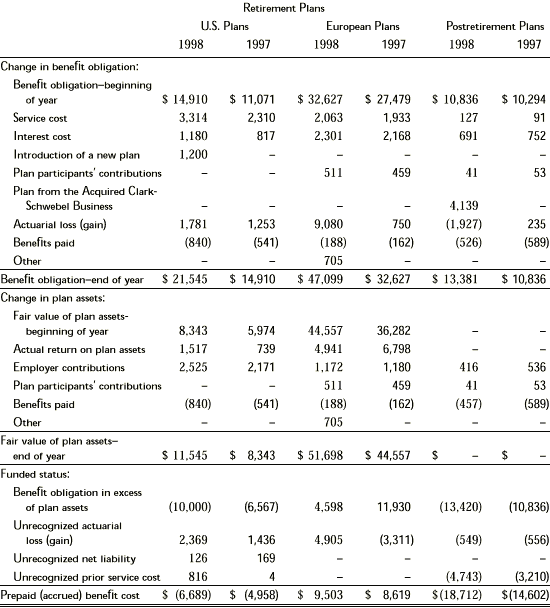
The projected benefit obligation, accumulated benefit obligation, and fair value of plan assets for pension plans with accumulated benefit obligations in excess of plan assets were $21,545, $18,858 and $11,545, respectively, as of December 31, 1998 and $14,910, $13,037 and $8,343, respectively, as of December 31, 1997. In 1998, the company updated certain assumptions with respect to its European plans, resulting in an actuarial loss. Amortization of this loss and other prior service costs, is calculated on a straight-line basis over the expected future years of service of the plans’ active participants. Assets for the defined benefit pension plans generally consist of publicly traded securities, bonds and cash investments.
As of December 31, 1998 and 1997, the prepaid benefit cost was included in “investment in affiliated companies and other assets” in the accompanying consolidated balance sheets. For the same periods, the accrued benefit cost was included in “accrued compensation and benefits” and “other non-current liabilities” in the accompanying consolidated balance sheets.
Assumptions used to estimate the actuarial present value of benefit obligations as of December 31, 1998, 1997 and 1996, were:
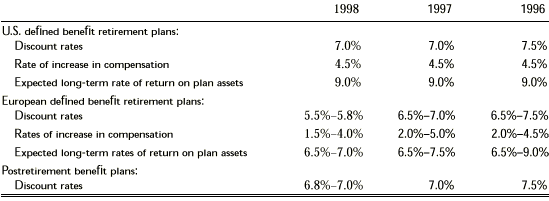
For measurement purposes, the annual rate of increase in the per capita cost of covered health care benefits were assumed at 7.5% to 10.2% for medical, and 5.0% for dental and vision for 1999. These rates were assumed to decrease gradually to 5.5% to 8.4%, and remain at 5.0%, respectively, by the year 2002.
The table below presents the impact of a one-percentage point increase and a one-percentage point decrease in the assumed health care cost trend on the total of service and interest cost components and on the postre-tirement benefit obligation.

N o t e 1 1 - I n c o m e T a x e s
Provision for Income
Taxes
Income (loss) before income taxes and the provision (benefit) for income
taxes for the years ended December 31, 1998, 1997 and 1996, were:
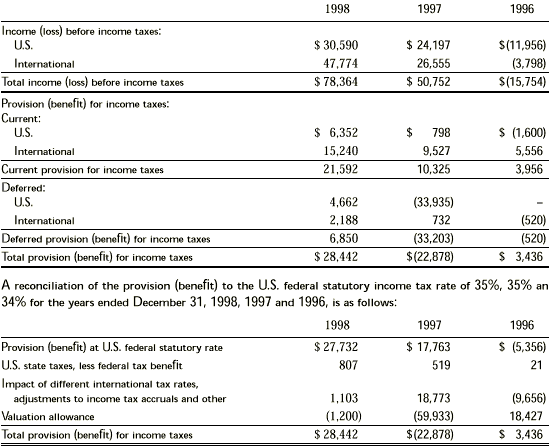
In accordance with SFAS No. 109, “Accounting for Income Taxes”, in 1996 the company had fully provided valuation allowance reserves against its net deferred tax assets primarily in the US and Belgium where there were uncertainties concerning the company’s ability to generate sufficient future taxable income to realize these assets. In 1997, the company reversed $59,900 of its valuation allowance reserve as follows: $17,000 due to current year profitable US operations, $39,000 due to the company’s assessment that the realization of the remaining US net deferred tax assets is more likely than not, and $3,900 in Belgium due to a gain on sale of certain tangible and intangible assets to other Hexcel subsidiaries. The company continues to reserve the balance of the net deferred tax asset related to its Belgium operations.
The company has made no US income tax provision for approximately $76,000 of undistributed earnings of international subsidiaries as of December 31, 1998. Such earnings are considered to be permanently reinvested. The additional US income tax on these earnings, if repatriated, would be offset in part by foreign tax credits.
Deferred Income
Taxes
Deferred income
taxes result from temporary differences between the recognition of items
for income tax purposes and financial reporting purposes. Principal temporary
differences as of December 31, 1998 and 1997, were:

Net
Operating Loss Carryforwards
As of December 31, 1998, Hexcel had net operating loss (“NOL”) carryforwards
for US federal and Belgium income tax purposes of approximately $45,000
and $4,500, respectively. The US NOL carryforwards, which are available
to offset future taxable income, expire at various dates through the year
2012. As a result of the ownership change, which occurred in connection
with the purchase of the Acquired Ciba Business, the company has a limitation
on the utilization of US NOL carryforwards of approximately $12,000 per
year.
N o t e 1 2 - S t o c k h o l d e r s’ E q u i t y
Common Stock Outstanding
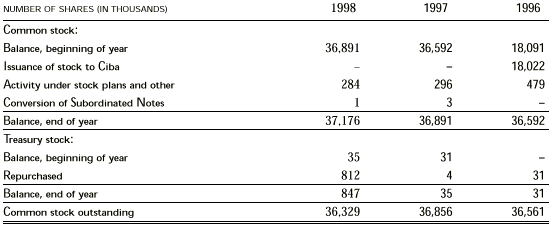
In 1998, the company’s Board of Directors approved plans to repurchase up to $20,000 of the company’s common stock. During the year ended December 31, 1998, the company repurchased 812 shares of its common stock at an average cost of $12.32 per share, for a total of $10,000. The Board of Directors may also approve additional stock buybacks from time to time subject to market conditions and the terms of the company’s credit agreements and indentures.
Stock-Based Incentive
Plans
The company has various stock option and management incentive plans for
eligible employees, officers, directors and consultants. These plans provide
for awards in the form of stock options, stock appreciation rights, restricted
stock, restricted stock units, and other stock-based awards. Options to
purchase common stock are generally granted at the fair market value on
the date of grant. Substantially all of these options have a ten-year
term and generally vest over a 3-year period. In 1998 and 1997, Hexcel’s
stockholders approved various amendments to the company’s stock-based
incentive plans, which increased the aggregate number of stock issuable
under these plans by 4,500 to 7,350.
As of December 31, 1998, 1997 and 1996, the company had outstanding a total of 518, 353 and 286, of performance accelerated restricted stock units (“PARS”), respectively. PARS are convertible to an equal number of shares of Hexcel common stock and generally vest in increments through 2005, subject to certain terms of employment and other circumstances which may accelerate the vesting period. As of December 31, 1998, 1997 and 1996, 301, 286, and 0 PARS were vested, respectively. Approximately $1,660, $3,272 and $529 of compensation expense was recognized in 1998, 1997 and 1996, respectively, with respect to the PARS and certain other stock-based incentive plans.
In addition to the above, during 1996, the company recognized $3,635 of compensation expense under the intrinsic value method resulting from stock options which vested in connection with the purchase of the Acquired Ciba Business. This compensation expense was based on the difference between the exercise price of the stock options granted and the market price of Hexcel common stock on the date that the company’s stockholders approved the Incentive Stock Plan under which these options were granted. The recognition of compensation expense in connection with these stock options resulted in a corresponding $3,635 increase in the additional paid-in capital of the company.
Stock option data for the three years ended December 31, 1998, 1997 and 1996, were:
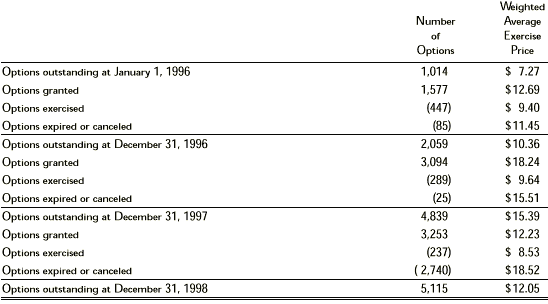
The number of options exercisable as of December 31, 1998, 1997 and 1996 were 1,505, 1,193 and 841, respectively, at a weighted average exercise price of $11.54, $9.80 and $8.64, respectively. The following table summarizes information about stock options outstanding at December 31, 1998:
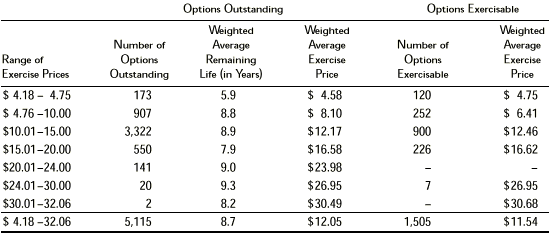
Employee
Stock Purchase Plan (“ESPP”)
In July 1997, the company established an ESPP to provide eligible employees
an additional opportunity to share in the ownership of Hexcel. The maximum
number of common stock reserved for issuance under the ESPP is 200. Under
the ESPP, eligible employees may contribute up to 10% of their base earnings
toward the quarterly purchase of the company’s common stock at a purchase
price equal to 85% of the fair market value of the common stock on the
purchase date. During 1998, approximately 36 common stock were issued
under the ESPP.
Pro Forma Disclosures
The company has elected to continue to follow APB Opinion No. 25 for accounting
for its stock-based incentive plans. Had compensation expense for the
company’s stock option plans been determined as prescribed by SFAS 123,
pro forma net income (loss) and related per share amounts, would have
been as follows:
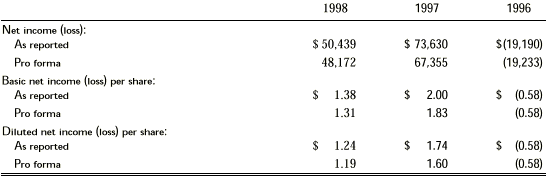
The weighted average fair value of options granted during 1998, 1997 and 1996 was $12.23, $18.24 and $12.75, respectively. The following ranges of assumptions were used in the Black-Scholes pricing models for options granted in 1998, 1997 and 1996: risk-free interest of 4.6% to 6.3%, estimated volatility of 40% to 51%, dividend yield of 0.0%, and an expected life of 1 to 10 years.
N o t e 1 3 - N e t I n c o m e (Loss ) P e r S h a r e
Computations of basic and diluted net income (loss) per share for the years ended December 31, 1998, 1997 and 1996, are as follows:
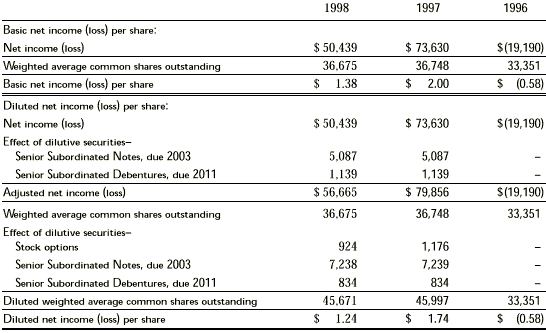
The Convertible Subordinated Notes, due 2003, which were issued in 1996, and the Convertible Subordinated Debentures, due 2011, were excluded from the 1996 computation of diluted net loss per share as they were antidilutive. Substantially all of the company’s stock options were included in the calculation of the diluted earnings per share for the years ended December 31, 1998 and 1997.
N o t e 1 4 - C o n t i n g e n c i e s
Hexcel is involved in litigation, investigations and claims arising out of the conduct of its business, including those relating to commercial transactions, and environmental, health and safety matters. The company estimates and accrues its liabilities resulting from such matters based on a variety of factors, including outstanding legal claims and proposed settlements, assessments by internal and external counsel of pending or threatened litigation, and assessments by environmental engineers and consultants of potential environmental liabilities and remediation costs. Such estimates exclude counterclaims against other third parties. Such estimates are not discounted to reflect the time value of money due to the uncertainty in estimating the timing of the expenditures, which may extend over several years. Although it is impossible to determine the level of future expenditures for legal, environmental and related matters with any degree of certainty, it is the company’s opinion, based on available information, that it is unlikely that these matters, individually or in the aggregate, will have a material adverse effect on the consolidated financial position, results of operations or cash flows of the company.
Legal and Environmental
Claims and Proceedings
Hexcel has been named as a potentially responsible party with respect
to several hazardous waste disposal sites that it does not own or possess
which are included on the Superfund National Priority List of the US Environmental
Protection Agency or on equivalent lists of various state governments.
The company believes that it has limited or no liability for cleanup costs
at these sites and intends to vigorously defend itself in these matters.
Pursuant to the New Jersey Environmental Responsibility and Clean-Up Act, Hexcel signed an administrative consent order to pay for the environmental remediation of a manufacturing facility it owns and formerly operated in Lodi, New Jersey. The company’s estimate of the remaining cost to satisfy this consent order is accrued in the accompanying consolidated balance sheets. The ultimate cost of remediating the Lodi site will depend on developing circumstances.
In connection with the purchase of the Acquired Ciba Business, Hexcel assumed various liabilities including a liability with respect to certain environmental remediation activities at an acquired facility in Kent, Washington. The company was a party to a cost sharing agreement regarding the operation of certain environmental remediation systems necessary to satisfy a post-closure care permit issued to a previous owner of the Kent site by the US Environmental Protection Agency. Under the terms of the cost sharing agreement, the company was obligated to reimburse the previous owner for a portion of the cost of the required reme-diation activities. The company has determined that the cost sharing agreement terminated on December 22, 1998, however, the other party disputes this determination. The company’s estimate of other costs associated with the cleanup of the Kent site are accrued in the accompanying consolidated balance sheets.
Product Claims
In 1993, Hexcel became aware of an aluminum honeycomb sandwich panel delamination
problem with panels produced by its wholly-owned Belgium subsidiary, Hexcel
Composites S.A., and installed in rail cars in France and Spain. Two customers
alleged that Hexcel Composites S.A. was responsible for the problem. In
1998, the company negotiated a settlement to be paid in 1999 with one
customer and the company expects to settle with the remaining customer
in 1999. The company’s estimated liability for this matter is accrued
in the accompanying consolidated balance sheets.
N o t e 1 5 – S u p p l e m e n t a l C a s h F l o w I n f o r m a t i o n
Supplemental cash flow information, including non-cash financing and investing activities, for the years ended December 31, 1998, 1997 and 1996, consist of the following:
